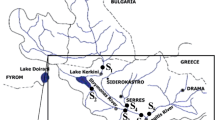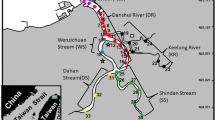Abstract
Purpose
A multi-compartment monitoring study was performed to characterize the effect of environmental variables, such as temperature and water flow as well as sediment characteristics, on the distribution and transport of persistent organic pollutants (POPs) in a dynamic river system during 1 year in an industrial region in central Europe.
Materials and methods
Waterborne polycyclic aromatic hydrocarbons (PAHs), polychlorinated biphenyls (PCBs) and organochlorine pesticides (OCPs) were assessed over a period of 1 year at five sampling sites in the Morava River in the Czech Republic. Contaminants were measured monthly in riverbed sediments, freshly deposited sediments, water samples and passive samplers.
Results and discussion
Sediments are the main carrier of POPs in the river. Distinguishable patterns of PAHs, OCPs and PCBs in sediment indicate that their origin is from distinct sources and different transport pathways. The PAHs were identified as the dominant contaminant group of compounds with a mean concentration in sediment of 5,900 μg kg−1. Such concentrations are up to 10 times higher than in the Danube River, into which Morava drains. In contrast, mean concentrations of PCBs, hexachlorocyclohexanes (HCHs), dichlorodiphenyltrichloroethane and its breakdown products (DDTs) and hexachlorobenzene (HCB) of 6.0, 0.4, 4.2 and 6.0 μg kg1, respectively, are similar to those in the Danube. With some exceptions, no significant difference in composition of surficial riverbed sediments and those collected using sediment traps was observed. Despite the presence of potential local pollutant sources, the differences in contaminant concentrations between sites in the region were in most cases not significant. Variations in POP concentrations in sediments are mainly induced by high flow events, whereas seasonal variability was not observed.
Conclusions
The changes in contaminant concentrations in Morava River sediments are induced by episodic high flow events that cause erosion of contaminant-containing particles and their deposition at suitable downstream sites.








Similar content being viewed by others
References
ARGE Elbe (2006) Gewaesserguetebericht der Elbe 2006. http://www.arge-elbe.de/wge/Download/Berichte/06Guetebericht.pdf. Accessed 20 Nov 2013
Bloesch J, Burns N (1980) A critical review of sedimentation trap technique. Schweizerische Zeitschrift für Hydrol 42:15–55
Cailleaud K, Forget-Leray J, Souissi S, Hilde D, LeMenach K, Budzinski H (2007) Seasonal variations of hydrophobic organic contaminant concentrations in the water-column of the Seine Estuary and their transfer to planktonic species. Part 1: PCBs and PAHs. Chemosphere 70:270–280
Di Toro DM, Zarba CS, Hansen DJ, Berry WJ, Swartz RC, Cowan CE, Pavlou SP, Allen HE, Thomas NA, Paquin PR (1991) Technical basis for establishing sediment quality criteria for nonionic organic chemicals using equilibrium partitioning. Environ Toxicol Chem 10:1541–1583
EU (2000) Directive 2000/60/EC of the European Parliament and of the Council of 23 October 2000 establishing a framework for community action in the field of water policy. Off J Eur Union L327:1–72
EU (2008) Directive 2008/105/EC of the European parliament and of the council of 16 December 2008 on environmental quality standards in the field of water policy. Off J Eur Union L348:84–96
Hilscherova K, Dusek L, Kubik V, Cupr P, Hofman J, Klanova J, Holoubek I (2007) Redistribution of organic pollutants in river sediments and alluvial soils related to major floods. J Soils Sediments 7:167–177
Hilscherová K, Dusek L, Sídlová T, Jálová V, Cupr P, Giesy JP, Nehyba S, Jarkovský J, Klánová J, Holoubek I (2010) Seasonally and regionally determined indication potential of bioassays in contaminated river sediments. Environ Toxicol Chem 29:522–534
Kersten M, Smedes F (2002) Normalization procedures for sediment contaminants in spatial and temporal monitoring. J Environ Monit 4:109–115
Koethe F (2003) Existing sediment management guidelines: an overview. What will happen with the sediment/dredged material? J Soils Sediments 3:139–143
Liska I, Slobodnik J, Wagner F (2008) Joint Danube survey 2. Final Scientific Report. Final Sci Rep 242
Lohmann R, Booij K, Smedes F, Vrana B (2012) Use of passive sampling devices for monitoring and compliance checking of POP concentrations in water. Environ Sci Pollut Res Int 19:1885–1895
Macikova P, Kalabova T, Klanova J, Kukucka P, Giesy JP, Hilscherova K (2014) Longer-term and short-term variability in pollution of fluvial sediments by dioxin-like and endocrine disruptive compounds. Environ Sci Pollut Res 21(7):5007–5022. doi:10.1007/s11356-013-2429-8
Morava River Basin Authority (2009a) Effect of measures on surface water—chemical status. http://www.pmo.cz/pop/2009/Morava/End/e-dopady/tabulky/te_1_1a.pdf. Accessed 18 Nov 2013
Morava River Basin Authority (2009b) Surface water bodies in Morava river basin, 2010–2015, Morava till confluence with Olsava. http://www.pmo.cz/pop/2009/Morava/End/inf_listy/prilohy/156.pdf. Accessed 18 Nov 2013
Morava River Basin Authority (2009c) Surface water bodies in Morava river basin, 2010–2015; Morava river till confluence with Drevnice. http://www.pmo.cz/pop/2009/Morava/End/inf_listy/prilohy/136.pdf. Accessed 18 Nov 2013
Morava River Basin Authority (2009d) Surface water bodies in Morava river basin, 2010–2015, Drevnice till confluence with Morava. http://www.pmo.cz/pop/2009/Morava/End/inf_listy/prilohy/149.pdf. Accessed 18 Nov 2013
Prokeš R, Vrana B, Klánová J (2012) Levels and distribution of dissolved hydrophobic organic contaminants in the Morava river in Zlín district, Czech Republic as derived from their accumulation in silicone rubber passive samplers. Environ Pollut 166:157–166
Reid BJ, Jones KC, Semple KT (2000) Bioavailability of persistent organic pollutants in soils and sediments—a perspective on mechanisms, consequences and assessment. Environ Pollut 108:103–112
Schwartz R, Gerth J, Neumann-Hense H, Förstner U (2006) Assessment of highly polluted fluvisol in the Spittelwasser floodplain based on national guideline values and MNA-Criteria. J Soils Sediments 6:145–155
Schwarzenbach RP, Gschwend PM, Imboden DM (1993) Environmental organic chemistry. Wiley-Interscience, New York
Smedes F, van Vliet LA, Booij K (2013) Multi-ratio equilibrium passive sampling method to estimate accessible and pore water concentrations of polycyclic aromatic hydrocarbons and polychlorinated biphenyls in sediment. Environ Sci Technol 47:510–517. doi:10.1021/es3040945
Viganò L, Arillo A, Buffagni A, Camusso M, Ciannarella R, Crosa G, Falugi C, Galassi S, Guzzella L, Lopez A, Mingazzini M, Pagnotta R, Patrolecco L, Tartari G, Valsecchi S (2003) Quality assessment of bed sediments of the Po River (Italy). Water Res 37:501–518
Vrana B, Klučárová V, Benická E, Abou-Mrad N, Amdany R, Horáková S, Draxler A, Humer F, Gans O (2014) Passive sampling: an effective method for monitoring seasonal and spatial variability of dissolved hydrophobic organic contaminants and metals in the Danube river. Environ Pollut 184:101–112
Acknowledgments
This research was supported by the Czech Ministry of Education (LO1214 and LM2011028).
Author information
Authors and Affiliations
Corresponding author
Electronic supplementary material
Below is the link to the electronic supplementary material.
ESM 1
(DOC 2.11 mb)
Rights and permissions
About this article
Cite this article
Prokeš, R., Vrana, B., Komprdová, K. et al. Annual dynamics of persistent organic pollutants in various aquatic matrices: a case study in the Morava River in Zlín district, Czech Republic. J Soils Sediments 14, 1738–1752 (2014). https://doi.org/10.1007/s11368-014-0931-3
Received:
Accepted:
Published:
Issue Date:
DOI: https://doi.org/10.1007/s11368-014-0931-3




